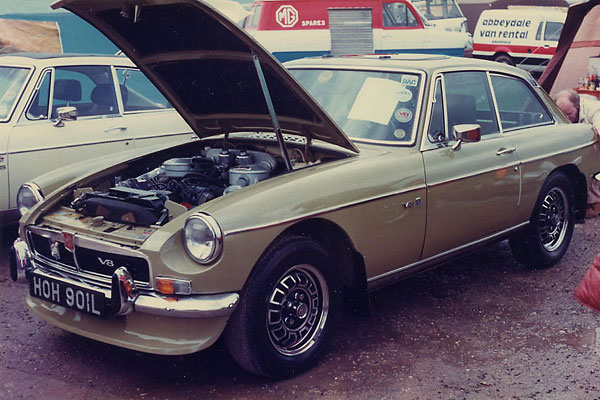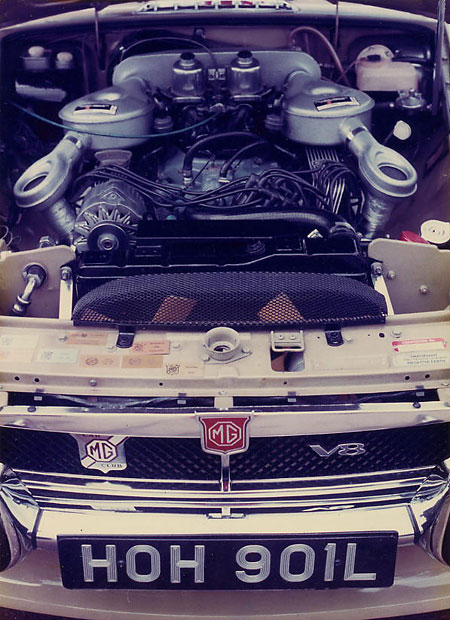�

�
�
Not to be published until Wednesday 15th August 1973�
�
MGB GT V8
�DESCRIPTION OF THE CAR
��
Introduced in 1965, the MGB fastback coupe, with its third door offering access �
to the rear interior of the body, has a compact, robust and stiff unitary �
structure. It is now offered in 3.5 litre V8 form as an option to the well proved �
1.8 litre B-series four cylinder engined version. Both these cars share rack and �
pinion steering, coil spring and unequal length wishbone independent front �
suspension, and a beam rear axle on half elliptic leaf springs, strengthened in �
the V8 to cope with almost double torque and power output. �
�
The body structure meets worldwide regulations for safety and survival in accidents, �
while padded fascias, safety switches, anti-burst locks, lights and other fittings �
meet both U.S. Federal and European Economic Community regulations. The steering �
wheel is fully padded. �
�
Equipment is complete and includes a concise complement of clear instruments, deep �
bucket seats and a large carpeted area at the rear capable of accommodating small �
children or a great deal of luggage. The big tail door swings high to give easy �
access to this area. �
3.5 LITRE ENGINE
��
Similar in many ways to the lightweight 3.5 litre unit installed by Rover 3500S and �
3500 since 1968, the V8 engine is tailored to the MGB GT installation by converting �
the penthouse carburetter manifold to one in which the carburetters are mounted at �
the rear of the engine. The other major change is to an AC Delco alternator. Free �
flow exhaust are also specified. �
�
Light alloy for the stiff block and for the heads make the basic V8 some 40 lbs �
lighter than the 1.8 litre four cylinder, which continues in the type, but with the �
inevitable complexity and weight of the ancillary equipment now essential to meet �
noise, emission and safety regulations, the total weight goes up to a little more �
than that of the 1.8 litre unit. Most of the extra weight is on the front wheels, �
the ratio from front to rear being 49.4/50.6% compared with the 47.8/52.2% of the �
four cylinder. �
�
The SU HIF 6 (horizontal integral float chamber) carburetters provide stable �
carburetion under all conditions of hard cornering, acceleration and braking. They �
are installed at the rear of the engine on a specially designed low-line manifold �
evolved by the long-time tuning wizards at MG to give dual benefits of greatly �
reduced temperature scatter from one cylinder to another, compared with the original �
penthouse manifold, and at the same time to make it possible to avoid the need for �
a 'power bulge' on the smooth contours of the bonnet. Neat bi-metallic valves are �
arranged to draw in warm air for the carburetters from sleeves on the exhaust �
manifolds, then to take in cooler air when the engine is warm.�
�
The short-stroke, big bore engine has five crankshaft bearings and the inclined �
overhead valves are actuated by hydraulic lifters and rockers from the central �
camshaft. The compression ratio is 8.25:1, maximum bhp (DIN) is 137 at 5,000 rpm; �
torque is 193 lb ft at 2,900 rpm.�
MECHANICAL REFINEMENT
��
Detail modifications have been carried out to the all-synchromesh C-type gearbox, �
transmission and rear axle. The gearbox casing has been redesigned to accept a �
larger clutch to match the substantial power increase of the V8 engine. As the �
torque is almost doubled compared with the four cylinder version, the intermediate �
gear ratios have been raised to meet the different output curve as well as to reduce �
the torque load into the box. The axle ratio is 3.07:1 as against 3.91:1 of the �
1.8 litre version. �
�
The clutch withdrawal race is now a ballrace instead of the more customary carbon �
bush, a design refinement initially found on the British Leyland transverse engine �
Maxi range.�
�
Installing the larger engine, which fully fills the engine bay, meant changes to �
the bulkhead and slight modifications to the inner wheel arches to clear the exhaust �
manifolds. There was a minor modification to the front crossmember to make space �
for ancillaries.�
�
To control the greatly increased torque, the rear half elliptic springs are �
substantially stiffer and heavier coil springs are specified at the front. The dampers �
are unchanged. �
STRONGEST WHEELS
�� New Dunlop 5J wheels with ventilated cast alloy centres riveted to chromed steel � rims are fitted with 175 HR x 14 tyres. The Abingdon engineers believe these are � the strongest wheels they have ever fitted. In the laboratory rig testing, up to � 600,000 load reversals were required. In this case the batch was taken off after � 3 million reversals and a single wheel, kept on for interest's sake, was still � going strong at six million load reversals. �
�QUIET COOLING
��
There is a larger radiator, equipped with two thermostatically controlled electric �
fans to reduce fan noise and power absorption. An oil radiator is also provided. �
�
From the driver's seat the view is much the same as on the smaller engined version, �
except that on right hand drive models sold in the United Kingdom, 80mm speedometers �
and tachometers replace the four inch instruments normally installed. A collapsible �
steering column, adopted in the interests of greater safety is the reason for the �
difference. �
FULLY EQUIPPED
��
Features to be specified as standard on the MGB GT V8 will include overdrive on �
top gear, brake servo, cast alloy special wheels, door mounted mirror, tinted �
window glasses, and the electrically operated cooling fans. �
�
� (b)�
�
�
Enjoying this article? Our magazine is funded through the generous support of readers like you!
�
To contribute to our operating budget, please click here and follow the instructions.
�
(Suggested contribution is twenty bucks per year. Feel free to give more!)�
�
At the British V8 Newsletter, we don't currently have access to the photo negatives, �
proofs, or artist renderings that probably accompanied the original text of the �
MGB GT V8 press release. We can only speculate on what sort of photography might �
have been included. Two selections are included below.�
�
The 1973 MGB GT V8 that carries license plate "HOH 901L" (series number 0118) �
belongs to Mike Dunlop, but we understand that originally this car was used as �
one of the main press demonstration and photography vehicles. (Our two photographs �
of it, shown here, date from July 1983 and were taken by Ken Smith at a "V8 �
Register" meet.) One thing that's interesting and unusual about this car is its �
paint color: "Limeflower" (not the more popular and widely known "Harvest Gold").�
It does show up great in photos! �
�

�
�

�
� Disclaimer: The last two paragraphs were written by Curtis Jacobson. Views � expressed are those of the author, and are provided without warrantee or guarantee. � Apply at your own risk.�
� This article is part of a set of FIVE! If you enjoyed this article, check out:
� MGB GT V8 Press Release - Introduction
� MGB GT V8 Press Release - "Development of the Body and the Engine"
� MGB GT V8 Press Release - "Grandest Tourer - Latest of a Line"
� MGB GT V8 Press Release - "Technical Specifications"
�
�
� BritishV8 Magazine has assembled the largest, most authoritative collection of MG � "MGB GT V8" information you'll find anywhere. Check it out! � Access our � MGB GT V8 article index by clicking here. �
�

